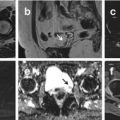and Jurgen J. Fütterer2, 3
(1)
Department of Radiological Sciences, Oncology and Pathology, Sapienza University of Rome, Rome, Italy
(2)
Department of Radiology and Nuclear Medicine, Radboudumc, Nijmegen, The Netherlands
(3)
MIRA Institute for Biomedical Technology and Technical Medicine, University of Twente, Enschede, The Netherlands
Ectopic Kidney
A renal ectopia is a birth defect in which the developmental of the kidney is characterized by abnormal anatomical location (arrest or exaggeration of normal caudal-to-cranial ascent of the kidney). The incidence is about 1/900 people.
Patients are most often asymptomatic. Normal pathology can affect ectopic kidneys, but because of the ectopic position, patients could refer nonclassical abdominal pain or urinary disorders.
Most common associations in patients with renal ectopia are multicystic dysplasia in a fused or unfused crossed kidney, ureterocele, ectopic ureteric orifice, and vesicoureteric reflux (see vesicoureteric reflux).
Ectopic kidney is often an incidental finding at abdominal ultrasonography. Around 50 % remain unrecognized throughout life.
Contrast-enhanced CT of the abdomen and pelvis shows the abnormalities in patients with renal ectopia.
MRI shows detailed anatomic position of dysplastic kidneys and eventually ectopic ureteral insertions and/or other associated malformations, in cases where other modalities, which use ionizing radiation or nephrotoxic contrast agents, have failed. One of the disadvantages of MRI includes the need for sedation or general anesthesia in most children.
Ejaculatory Dysfunction, MR of
MRI with an endorectal coil has been used in man with ejaculatory dysfunction to identify developmental abnormalities of the prostate and seminal vesicles.
Prostatic cysts along the course of the ejaculatory ducts, seminal vesicle cysts associated with ipsilateral seminal vesicle and renal agenesis, and seminal vesicle calculi can be identified. Evidence of hemorrhage is often seen in the seminal vesicles (short T1 of fluid) in men with hemospermia.
The normal seminal vesicles measure about 3 cm in length and about 1.5 cm in diameter, with a normal volume of about 13.7 mL. The walls of the seminal vesicles are normally 1–2-mm thick at MR imaging. The ampullae of the vas deferens measure 0.4 cm ± 0.1 in diameter. The ejaculatory ducts measure approximately 4–8 mm in diameter.
Utricle cysts are pear-shaped structures that, unlike Müllerian duct cysts, do not extend above the base of the prostate. They communicate freely with the prostatic urethra.
Müllerian duct cysts result from focal failure of regression and focal saccular dilatation of the mesonephric duct. They appear as teardrop-shaped midline cysts extending above the prostate. They do not communicate with the posterior urethra whereas utricle cysts do. These cysts may also cause ejaculatory impairment by obstructing the ejaculatory duct in the midline.
Endometrial Carcinoma
Cancer of the endometrium is the most common invasive gynecological malignancy in Europe and the United States. The median age of occurrence is 63 years, though 12 % of cases are present in premenopausal women.
Clinical presentation commonly is a postmenopausal bleeding.
The most common histological type is endometrioid adenocarcinoma (75 %); less common types are papillary serous carcinoma, clear cell carcinoma, adenosquamous carcinoma, and undifferentiated carcinoma.
Staging of endometrial carcinoma is based on the FIGO staging system, which uses a surgical and pathological staging following total abdominal hysterectomy, salpingo-oophorectomy, lymphadenectomy, and peritoneal washings. Tumors are staged on the basis of depth of myometrial invasion.
US signs of endometrial cancer include heterogeneity and irregular endometrial thickening. Polypoid tumors tend to cause more diffuse and irregular thickening than a polyp and more heterogeneity than endometrial hyperplasia. A uterine fluid collection should raise the concern of underlying malignancy.
CT is most commonly used to study extent of spread of endometrial cancer, but it’s necessary to administer oral, rectal, and IV contrast material. CT findings may include the following:
Hypoattenuated mass in the region of the endometrial cavity, which may show uniform attenuation or may be heterogeneous, with or without a contrast-enhanced component
Polypoid mass surrounded by endometrial fluid
Heterogeneous soft tissue mass/masses and fluid expanding the endometrial cavity
Fluid-filled uterine cavity marginated by mural tumor implants
The reported overall accuracy of CT staging ranges from 84 to 88 %.
A dedicated pelvic MRI protocol is valuable in the evaluation of endometrial cancer. The imaging protocol consist of using a phased-array coil, administering antiperistaltic agents, using high-resolution sagittal and axial T2-weighted sequences, and using axial T1-weighted spoiled gradient-echo images for lymph nodes study and sagittal T1-weighted spoiled gradient-echo sequences following IV injection of paramagnetic contrast material.
MRI has proven to be an important tool for the staging of known endometrial carcinoma: MRI can differentiate between superficial and deep-muscle-invasive tumors, such important information for surgical management.
Stay updated, free articles. Join our Telegram channel

Full access? Get Clinical Tree




